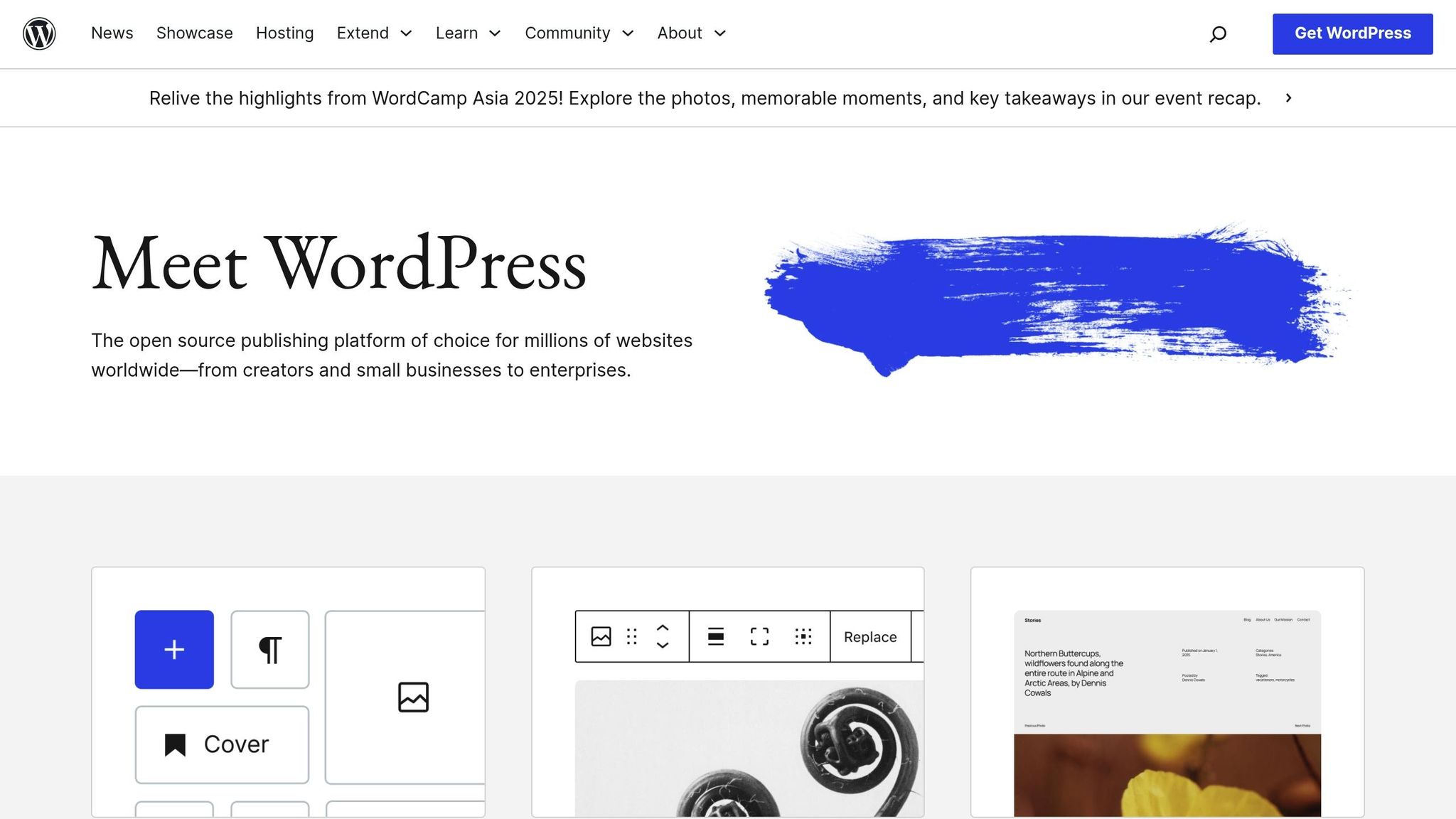5 DDoS Mitigation Techniques for WordPress Sites

DDoS attacks can cripple your WordPress site, causing downtime, slow performance, and lost revenue. To protect your site and maintain a reliable online presence, here are five effective strategies to mitigate DDoS attacks:
- Rate Limiting: Restrict the number of requests from a single IP to prevent overwhelming traffic.
- Web Application Firewall (WAF): Block malicious traffic and application-layer attacks.
- Content Delivery Network (CDN): Distribute traffic across multiple servers and cache static content to reduce server load.
- Server-Level DDoS Protection: Filter harmful traffic at the network level and monitor for unusual patterns.
- Attack Monitoring: Use tools to detect and respond to suspicious activity in real time.
DDoS Attacks: What WordPress Users Need to Know

What Are DDoS Attacks on WordPress?
A DDoS attack uses a network of compromised systems to flood a WordPress site with traffic, draining its resources. This flood of traffic makes the site sluggish or completely unavailable to real users.
WordPress sites typically face three main types of DDoS attacks. Knowing these attack patterns helps you prepare the right defenses:
- Volume-Based Attacks
These attacks overload the network by flooding it with traffic. Examples include:
- UDP floods targeting login pages
- ICMP floods aimed at the site’s core infrastructure
- Spoofed-packet floods directed at hosting servers
- Protocol Attacks
These attacks exploit network protocols to drain server resources. Common methods are:
- SYN floods that overwhelm connection handling
- Fragmented packet attacks consuming server memory
- Other protocol-based disruptions that interrupt normal operations
- Application Layer Attacks
These focus on specific WordPress functions and endpoints, such as:
- Overloading the XML-RPC interface to crash the server
- Straining databases with excessive requests
WordPress sites are particularly at risk due to their popularity and the exposure of common elements like:
- wp-login.php: A frequent target for brute force and flood attacks
- wp-admin: The admin dashboard, often hit with application-level attacks
- xmlrpc.php: An API endpoint commonly abused for amplification attacks
The effects of these attacks can be severe, disrupting key functions by exhausting resources like database connections, PHP processing power, server memory, or network bandwidth.
Understanding these attack types is the first step to securing your site. In the next sections, we’ll dive into strategies to counter each type of DDoS attack.
1. Set Up Rate Limiting
Rate limiting is a straightforward way to protect against DDoS attacks. It works by controlling how many requests a single IP address can make within a set period.
How It Works
Rate limiting keeps track of incoming requests and blocks IP addresses that exceed the defined request limits.
Steps to Implement
Here’s how you can put rate limiting into action:
- Configure Server-Level Rate Limiting
For example, on an Apache server, you can use the following setup:
<IfModule mod_ratelimit.c>
SetOutputFilter RATE_LIMIT
SetEnv rate-limit 400
</IfModule>
<LocationMatch "wp-login.php">
LimitRequestBody 10000
SetEnvIf Request_URI "wp-login.php" limited
</LocationMatch>
- Use Application-Level Controls
If you’re using WordPress, security plugins allow you to limit specific actions like login attempts, XML-RPC requests, comment submissions, and REST API calls.
Optimizing Performance
Start with conservative limits, whitelist trusted IPs, and fine-tune settings based on your traffic patterns.
Monitoring and Adjustments
Keep an eye on resource usage and blocked requests. Adjust thresholds as needed to ensure protection without affecting legitimate users.
Rate limiting is a solid way to counter basic DDoS attacks while maintaining a good user experience. For even stronger protection, consider adding a Web Application Firewall.
2. Install a Web Application Firewall
Once you’ve set up rate limits, the next step is to add a Web Application Firewall (WAF). A WAF acts as a shield for your WordPress site, filtering out harmful traffic, including threats like DDoS attacks. It works by analyzing incoming HTTP/HTTPS requests in real time, identifying suspicious patterns, and blocking them before they can harm your server.
How WAFs Help Against DDoS
WAFs rely on filtering rules to:
- Monitor traffic for unusual patterns
- Block suspicious IP addresses
- Stop malformed HTTP requests
- Prevent application layer (Layer 7) DDoS attacks
Steps to Set Up a WAF
-
Pick the Right Type
Decide between a cloud-based or server-side WAF. Cloud-based options are easier to set up and maintain, while server-side solutions give you more control over specific settings. -
Set Up Basic Rules
Configure essential security features such as request rate limits, geographic IP filtering, blocking known attack patterns, and creating custom rules for WordPress-specific vulnerabilities. -
Optimize for Performance
Adjust the firewall to ensure your site remains fast. Enable caching for static content, set proper timeout values, and create whitelists for legitimate traffic.
Ongoing Monitoring and Updates
After installing the WAF, keep an eye on its logs to spot new threats. Regularly update your rule sets as attacks evolve, monitor resource usage, and tweak security policies to keep your site protected.
sbb-itb-d55364e
3. Use a Content Delivery Network
A Content Delivery Network (CDN) helps protect your WordPress site from DDoS attacks while improving its performance. It works by redirecting and filtering incoming traffic, reducing the burden on your origin server.
Here are three key ways a CDN protects and optimizes your site:
- Traffic Distribution: Spreads requests across multiple servers to avoid overload and routes traffic to the closest data center for faster response times.
- Attack Detection: Monitors traffic patterns in real time, filters based on geographic or network behavior, and blocks suspicious or harmful requests.
- Resource Caching: Stores static content closer to your visitors, reducing the strain on your main server during high-traffic periods.
A CDN, much like rate limiting and Web Application Firewalls (WAFs), adds an essential layer of security. To set it up:
- Choose a CDN Plan: Consider your site’s bandwidth needs, the areas you want to cover, and the security features offered.
- Configure DNS Settings: Update your domain’s DNS records (like CNAME or A records) and install SSL certificates to connect your site to the CDN.
- Optimize CDN Settings: Enable DDoS protection, set caching rules, configure security policies, and establish rate-limiting thresholds.
In addition to protecting against DDoS attacks, a CDN enhances your site’s speed and performance by reducing latency and conserving server resources.
4. Enable Server DDoS Protection
Once you’ve set up defenses at the application level, it’s time to strengthen your site with server-level protections. Server DDoS protection works by filtering harmful traffic at the network layer, stopping large-scale attacks before they overwhelm your server.
Here’s what server DDoS protection typically involves:
- Network Monitoring: Keep an eye on incoming traffic to spot unusual patterns that might indicate an attack. This includes monitoring packet rates, connection attempts, traffic distribution across protocols, and the geographic sources of requests.
- Traffic Filtering: Set up automated rules to block harmful IP ranges, drop suspicious packets, and control abnormal connection rates.
- Resource Management: Fine-tune your server settings to handle heavy traffic more effectively. This can include adjusting connection timeouts, limiting simultaneous connections, and allocating enough CPU and memory for traffic analysis.
These measures work alongside tools like web application firewalls (WAFs) and content delivery networks (CDNs) to create a more comprehensive security strategy.
Steps to Implement Server DDoS Protection
- Work with your hosting provider to enable any built-in DDoS protection features they offer.
- Set up your firewall (for example, using iptables) and establish baseline monitoring rules.
- Develop automated response protocols to quickly react to attacks as soon as they’re detected.
Keep in mind, implementing these protections might require extra server resources for real-time traffic analysis. Pair these server-level defenses with other security layers like WAFs and CDNs, and regularly update your configurations to keep up with new attack methods.
5. Set Up Attack Monitoring
After implementing strong server-level defenses, the next step is continuous monitoring to protect your WordPress site from DDoS attacks. Monitoring helps you detect unusual activity and respond quickly.
Key Monitoring Tools and Alerts
To stay ahead, use traffic analysis tools. Here’s what you should focus on:
- Turn on server logging to keep track of activity.
- Monitor connection attempts and their origins.
- Analyze incoming requests to identify unusual patterns.
Set up automated alerts for:
- Traffic surges that seem out of the ordinary.
- Access from unexpected geographic locations.
- Excessive use of server resources, like CPU or bandwidth.
- Suspicious login attempts or repeated failures.
Once your tools and alerts are ready, follow a systemized approach to monitor and respond effectively.
Steps to Implement Monitoring
1. Configure Server-Side Monitoring
- Enable detailed logging for your web server to record activity.
- Monitor resource usage, such as CPU, memory, and bandwidth.
- Use tools to analyze network traffic for irregularities.
2. Set Alert Thresholds
- Identify your site’s normal traffic patterns.
- Configure alerts for unusual spikes or extended high server usage.
- Watch for memory usage that deviates from the baseline.
3. Prepare a Response Plan
- Create a documented protocol for handling attacks.
- Maintain an updated list of contacts for incident response.
- Back up server configurations regularly.
- Test and update your response plan to ensure it’s effective.
Resources You’ll Need
To set up proper monitoring, make sure you have:
- A dedicated monitoring server or service.
- Enough resources to handle detailed logging.
- Adequate storage for keeping log histories.
- An automated system to back up your logs and configurations.
Tips for Monitoring Success
- Regularly review your monitoring logs for unusual activity.
- Adjust alert thresholds as your traffic patterns change.
- Keep your monitoring tools updated to handle new threats.
- Document any security incidents for future reference.
- Periodically test your monitoring system to ensure accuracy.
Conclusion
To safeguard your WordPress site from DDoS attacks, it’s crucial to combine multiple protective measures. Using the five strategies outlined – rate limiting, web application firewalls (WAFs), content delivery networks (CDNs), server-level defenses, and attack monitoring – can strengthen your site’s ability to handle such threats.
Steps to Get Started:
- Configure rate limiting and a WAF as your first line of defense.
- Incorporate a CDN for more comprehensive coverage.
- Set up strong server-level protections.
- Ensure your monitoring systems are active and regularly updated.
While these actions are essential, choosing a hosting provider with strong DDoS mitigation capabilities is just as important. For example, a provider like Osom WP Host can help evaluate your security needs and connect you with suitable hosting solutions.
For long-term protection, consider these practices:
- Regularly review and update your security settings.
- Keep all protective layers in sync and up to date.
- Document and analyze any security incidents.
- Stay informed about new DDoS attack methods.
- Confirm that your hosting infrastructure supports your security measures effectively.
